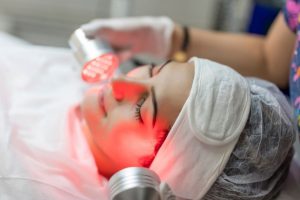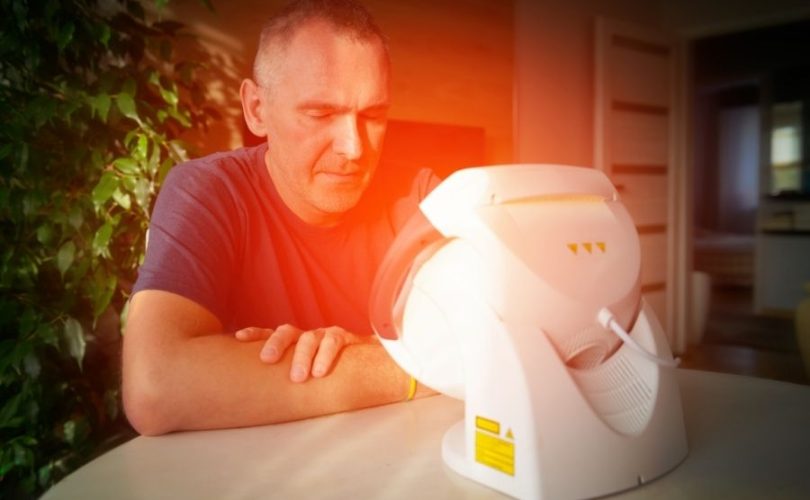Picture the first rays of sunlight gently kissing the earth at dawn. The mere sight invokes a sense of warmth and vitality, filling our hearts with joy and optimism. Unfortunately, this absence might be a tad more challenging for some people.
As the seasons change, so can our emotional landscape. Many people experience a specific type of depression called Seasonal Affective Disorder (SAD) during the colder, darker months.
It’s as if the sun takes a break, and the lack of natural light can plunge individuals into a deep emotional abyss. That’s where the best light therapy lamp saves the day.
How does this therapy work on depression? What’s the deal? This article is the enlightening resource you need to answer all your questions, so- don’t hesitate to plunge in!
What Is Light Therapy?
Light therapy for depression, also known as bright light therapy or phototherapy, is a non-invasive treatment that involves exposure to bright artificial light to alleviate symptoms of depression. This is particularly effective for individuals experiencing Seasonal Affective Disorder (SAD).
What is SAD? It’s a type of depression that occurs cyclically, usually during the fall and winter months when there is less natural sunlight. Light therapy may also work alongside other treatments to reduce the symptoms of other major depressive disorders like morning depression.
The underlying principle of light therapy for depression revolves around the relationship between light and our circadian rhythms. The lack of sunlight during the darker months can disrupt the body’s internal clock. This may lead to imbalances in neurotransmitters like serotonin and melatonin, which regulate mood, sleep, and other physiological processes.
The therapy aims to mimic natural sunlight and trigger positive chemical reactions in the brain by exposing individuals to specific light wavelengths, typically through specially designed light boxes.
Why Do People Develop SAD?
Some depressions may be linked to severe fatigue, but the exact cause of SAD is not fully understood. In fact, several factors contribute to its development:
Vitamin D Deficiency
Sunlight exposure is essential for the production of vitamin D in the body. During the winter, when there is less sunlight, some individuals may experience vitamin D deficiency. And this increases the risk of depression.
Reduced Sunlight Exposure
The primary trigger for SAD is reduced natural sunlight during the winter months. Sunlight regulates the body’s internal clock and influences various physiological processes. Thus, reduced exposure to sunlight can disrupt these biochemical processes, leading to mood changes and other symptoms associated with depression.
Biological Clock Disruption
Our bodies have an internal biological clock, known as the circadian rhythm, which regulates our sleep-wake cycle and various other physiological patterns. The decrease in daylight during the winter can disrupt this circadian rhythm, leading to sleep disturbances, fatigue, and mood changes.
How Does Light Therapy Treat Depression?
The mechanics of light therapy are ingeniously simple. Like a radiant sun in a box, a specially designed lightbox emits bright, full-spectrum light that mimics natural sunlight.
How does light therapy work to treat SAD?
Restoring Circadian Rhythms
Our bodies have internal biological clocks, known as circadian rhythms, which structure sleep-wake cycles and various physiological processes. Light therapy helps synchronize these rhythms with the external day-night cycle, promoting better sleep and restoring balance.
Boosting Serotonin Levels
Light therapy increases serotonin production, a neurotransmitter regulating mood and emotional well-being. Higher serotonin levels boost mood and reduce feelings of sadness or anxiety. By extension, it could also help you cope with chronic fatigue syndrome.
Suppressing Melatonin Production
Light therapy, especially in the morning, suppresses the production of melatonin, a hormone responsible for regulating sleep. This helps individuals feel more energized and less tired during the day.
Stimulating Brain Activity
Exposure to bright light stimulates specific areas of the brain involved in mood regulation and emotional processing, contributing to the therapeutic effects of light therapy.
Providing a Positive Routine
It encourages setting aside time each day for the treatment and creates a consistent and positive routine to impact mood and motivation positively.
How To Pick The Right Light Therapy Box?
While treating seasonal depression with light therapy, the best you can do is to get it right. Here are some essential factors to consider when picking the correct lightbox:
Light Intensity
The intensity of the light box is a critical factor in its effectiveness. Look for a light box that provides at least 10,000 lux of light intensity at a comfortable sitting distance (usually around 16-24 inches from your face). The higher the lux value, the shorter the recommended daily session duration.
Full-Spectrum Light
Opt for a light box that emits full-spectrum light, which closely replicates natural sunlight. Full-spectrum light is preferred because it includes all visible spectrum colors and provides a more balanced and pleasant experience.
UV Filters
Ensure the lightbox has built-in UV filters to protect your eyes and skin from harmful ultraviolet rays. High-quality light boxes will filter out harmful UV rays for safety purposes.
Size and Portability
Consider the lightbox size and whether it fits comfortably into your living space or work area. Some light boxes are portable and easy to move, while others are larger and more suitable for stationary use.
Adjustable Stand or Mounting Options
Look for a light box with an adjustable stand or various mounting options. This allows you to position the light at the optimal angle and height for your comfort during the therapy sessions.
Glare-Free Surface
A glare-free surface on the lightbox helps prevent eye strain and ensures a more comfortable experience during light therapy sessions.
Timer and Controls
A built-in timer and easy-to-use controls are helpful features. Timers allow you to set session durations, and user-friendly controls make it convenient to adjust the light intensity.
What Is The Side Effects Of Light Therapy?
The side effects of treating seasonal or major depression with light therapy are usually mild and temporary. It dissipates as quickly as the morning mist under the sun’s warmth. However, awareness of potential side effects ensures a safe and effective light therapy experience.
Eye Strain
Prolonged exposure to the intense light emitted by light therapy devices causes eye discomfort or strain. To minimize this effect, maintain a comfortable distance from the light source and don’t stare directly into the light.
Headaches
Some individuals may experience headaches during or after light therapy sessions. Adjusting the duration or intensity of the light, as well as the positioning of the lightbox, mitigates this side effect.
Agitation
In rare cases, light therapy intensifies feelings of agitation or restlessness. If you notice any emotional discomfort during the therapy, communicate it to your healthcare provider.
Nausea
For a minority, exposure to bright light causes mild nausea, particularly if they are sensitive to intense illumination. Reducing the session duration or opting for lower light intensity might alleviate this side effect.
Sleep Disturbances
Light therapy sessions, especially in the evening, can disrupt sleep patterns for some individuals. To avoid this, scheduling sessions earlier in the day and not close to bedtime is advisable.
Skin Sensitivity
In rare instances, light therapy causes skin irritation or sensitivity. If you notice any adverse skin reactions, consult a healthcare professional and discontinue the therapy until the issue is addressed.
Mania or Hypomania
Individuals with bipolar disorder might be susceptible to experiencing manic or hypomanic episodes triggered by light therapy. If you have a history of bipolar disorder, it is crucial to speak with your healthcare provider before starting light therapy to assess potential risks and benefits.
How To Use Light Therapy
Before starting light therapy, we suggest consulting a healthcare professional or mental health specialist. They can diagnose SAD and recommend the appropriate light therapy treatment plan based on your needs and condition.
To begin light therapy, individuals must acquire a light therapy box emitting high-intensity light. It is crucial to ensure its effectiveness when choosing a box that provides approximately 10,000 lux of intensity. Moreover, light therapy lamps serve various purposes for skin disorders. The ones made explicitly for skin treatments emit UV light which could be harsh on the eye.

A consistent daily routine is another tip for a successful bright light treatment. Using the lightbox daily is generally recommended to regulate the body’s internal clock and improve mood.
Also, position the lightbox correctly to maximize its effectiveness. The lightbox should be at eye level but avoid directly glaring at it. Instead, set it to the side, allowing the light to enter your peripheral vision. Sessions typically last between 20 to 30 minutes, and the specific duration should hinge on your needs as advised by a professional.
During the treatment period, monitor your progress closely. Keeping track of mood and symptom changes can help you evaluate the therapy’s effectiveness and make any necessary adjustments. If you sense any adverse effects or if depression symptoms persist or worsen, inform your healthcare professional promptly.
Summary
If you find yourself treading through the fog of depression or navigating the labyrinth of SAD, light therapy might just be the beacon you seek.
However, like any constellation of hope, it’s essential to consult a knowledgeable mental health professional before trying it. Note that this shouldn’t replace other treatments like talk therapy and antidepressant medication.
Light therapy for depression is generally well-tolerated, with minimal side effects like eye strain or headaches, but individual responses can vary. A mental health specialist can tailor the therapy to suit your needs and guide you toward healing.





